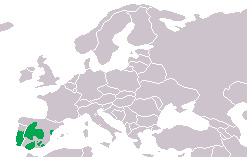
Animal description
The Iberian ribbed newt, scientifically known as Pleurodeles waltl, is a fascinating and unique amphibian native to the Iberian Peninsula and parts of Morocco. This species is notable for its distinctive defense mechanism, as well as its robust size, making it one of the largest members of the newt family. The Iberian ribbed newt has captured the interest of scientists and herpetologists worldwide due to its remarkable biological features and adaptability to various environments.Physically, the Iberian ribbed newt can reach lengths of up to 30 centimeters, making it an impressively sized specimen for a newt. Its skin is predominantly dark with a rough texture, adorned with lighter spots or streaks that provide camouflage in its natural habitat. The belly is usually lighter, ranging from yellow to orange, creating a striking contrast with the darker dorsal side. One of the most distinctive features of this species is its ribbed sides. In an extraordinary display of defense, the Iberian ribbed newt can protrude its ribs through its skin when threatened, with the ribs acting as sharp deterrents to potential predators. This process is facilitated by the newt's ability to increase its body size by inhaling air, making the ribs pierce through the skin more prominently. Remarkably, this does not cause the newt any apparent harm, as its skin is capable of rapid healing, and the ribs are coated with a toxic secretion that deters predators further.
Habitat-wise, the Iberian ribbed newt is quite versatile, inhabiting a variety of aquatic environments from slow-moving streams and ponds to man-made reservoirs. They are nocturnal creatures, spending the day hidden under rocks or in crevices, emerging at night to hunt. Their diet primarily consists of small invertebrates, including worms, insects, and crustaceans. During the breeding season, which typically occurs in the cooler months, males develop distinct physical characteristics, such as a more pronounced tail fin, to attract females. The females lay eggs on submerged vegetation, where they remain until hatching.
In terms of conservation status, the Iberian ribbed newt is considered to be of Least Concern by the International Union for Conservation of Nature (IUCN), though its populations are affected by habitat loss, pollution, and introduction of invasive species. Conservation efforts are focused on habitat preservation and monitoring of wild populations to ensure the species' longevity.
The Iberian ribbed newt's unique features have not only made it a subject of scientific study but have also led to its use in research, particularly in the fields of regenerative medicine and space biology. Its remarkable ability to regenerate lost or damaged tissues, and the study of its embryos in microgravity conditions aboard the International Space Station, underscore its potential contribution to understanding fundamental biological processes and applications in human medicine.
In summary, the Iberian ribbed newt is a captivating species with a range of extraordinary adaptations that allow it to thrive in its natural habitat. Its unique defense mechanism, significant size, and adaptability make it a standout among amphibians, while its role in scientific research highlights its importance beyond the realms of natural history.
Map of occurrence

Similar Animals
New photos of animals
Top 10 animals
- Dolphin gull (Leucophaeus scoresbii)
- Diana monkey (Cercopithecus diana)
- Moustached guenon (Cercopithecus cephus)
- Galápagos tortoise (Geochelone nigra complex)
- Japanese macaque (Macaca fuscata)
- Russian tortoise (Testudo horsfieldii)
- Stone loach (Barbatula barbatula)
- Greek tortoise (Testudo graeca)
- Common flying dragon (Draco volans)
- Vendace (Coregonus albula)


